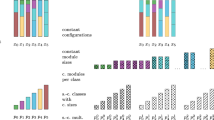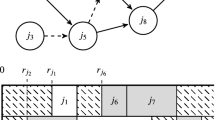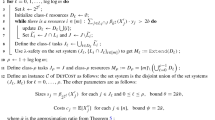Abstract
The setup problem is the following single‐machine scheduling problem:There are n jobs with individual processing times, arbitrary precedence relations andsequence‐dependent setup costs (or changeover times).The setup cost s ef arises in a schedule if job f is processed immediately after job e, e.g., the machine must be cleanedof e and prepared for f. The goal is to find aschedule minimizing the total setup costs (and thus, for changeover times, themakespan).We consider the case of “precedence‐induced” setup costs where a nonzero term s ef occurs only if e and fare unrelated with respect to the precedence relations. Moreover, we assume that the setupcosts depend only on f, i.e., s ef = s f for alle which are unrelated to f. Twospecial cases of the setup problem with precedence‐induced setup costs are the jumpnumberproblem and the bump number problem.We suggest a new polyhedral model for the precedence‐induced setup problem. To everylinear extension L = e 1 e 2...e n of a poset P = (P 1 <)with n elements, we associate a 0, 1- vector\(x^L \in \mathbb{R}^P \) with \(x_e^L = 1\) if and only ife starts a chain in \(L\left( {e = e_1 {\text{ or }}e = e_{i + 1} \parallel e_i } \right)\).The setup polytope \(S\) is the convex hull of the incidence vectors of alllinear extensions of P. For N-sparse posetsP, i.e., posets whose comparability graph isP 4-sparse, we give a completelinear description of S . The integrality part of the proof employsthe concept of box total dual integrality.
Similar content being viewed by others
References
A. von Arnim, R. Schrader and Y. Wang, The permutahedron of N-sparse posets, Math. Progr. A75(1996)1-18.
V. Bouchitté and M. Habib, Some NP-completeness properties about linear extensions, Order 4(1987)134-154.
M. Chein and M. Habib, The jump number of dags and posets: An introduction, Ann. Discr. Math. 9(1980)189-194.
A. Cournier and M. Habib, A new linear time algorithm for modular decomposition, in: Trees in Algebra and Programming, CAAP '94, ed. S. Tison, Lecture Notes in Computer Science 787, Springer, Berlin, 1994, pp. 68-84.
E. Dahlhaus, J. Gustedt and R. McConnell, A practical and efficient algorithm for substitution decomposition, in: Proceedings of the 8th Annual ACM-SIAM Symposium on Discrete Algorithms, ACM Press, New Orleans, LA, 1997, pp. 26-35.
J. Edmonds and R. Giles, A min-max relation for submodular functions on graphs, Ann. Discr. Math. 1(1977)185-204.
U. Faigle and R. Schrader, Minimizing completion time for a class of scheduling problems, Inform. Proc. Letters 19(1984)27-29.
U. Faigle and R. Schrader, Setup optimization problems with matroid structure, Order 4(1987)43-54.
L. Finta and Z. Liu, Single machine scheduling subject to precedence delays, Discr. Appl. Math. 70(1996)247-266.
M. Habib, R.H. Möhring and G. Steiner, Computing the bump number is easy, Order 5(1988)107-129.
M. McConnell and J.P. Spinrad, Linear-time modular decomposition and efficient transitive orientation of comparability graphs, in: Proceedings of the 5th Annual ACM-SIAM Symposium on Discrete Algorithms, ACM, Arlington, VA, 1994, pp. 536-544.
A.A. Schäffer and B.B. Simons, Computing the bump number with techniques from two-processor scheduling, Order 5(1988)131-141.
A. Schrijver, Theory of Linear and Integer Programming, Wiley, Chichester, 1986.
R. Schrader and G. Wambach, The setup polyhedron of series-parallel posets, Discr. Appl. Math. 79(1997)213-231.
G. Steiner, On finding the jump number of a partial orderby substitution decomposition, Order 2(1985)9-25.
Rights and permissions
About this article
Cite this article
Schrader, R., Wambach, G. The setup polytope of N‐sparse posets. Annals of Operations Research 92, 125–142 (1999). https://doi.org/10.1023/A:1018926512983
Issue Date:
DOI: https://doi.org/10.1023/A:1018926512983




